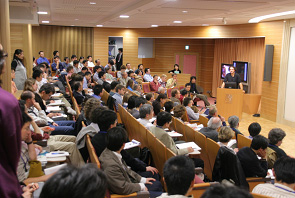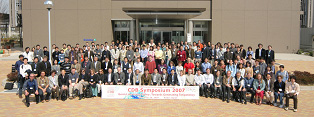| RIKEN Center for Developmental Biology (CDB) 2-2-3 Minatojima minamimachi, Chuo-ku, Kobe 650-0047, Japan |
“The 2007 CDB Symposium featured, just as the title promised, many talks on the acquisition of totipotency by cells of the germline, pluripotency in embryonic stem cells, and the epigenetic and transcriptional machineries needed to maintain these states. Research into germ cell biology has a long, proud history. And now, with all the recent interest in reproductive and regenerative medicine, we see more and more reports on both pluripotent ES cells and germline cells, the only cells capable of becoming truly totipotent, and many images from the field even featured on the covers of journals. This year’s symposium brought together an impressive program of respected speakers and established scientists, and with just the right number of participants and enthusiastic discussion following talks and at the posters, there were more than a few times when I (and I suppose others in the audience as well) heard something that made me think, “Now that’s really interesting!” One talk that made a realimpression on me was the presentation by Geraldine Seydoux (Johns Hopkins University, USA) on the RNA-protein complexes known as p-bodies, which repress transcription and degrade maternal transcripts. In the roundworm C. elegans, fertilized eggs contain germplasm, transcription is stopped in germline cells, and maternal RNAs are protected from degradation at the translational level. In contrast, maternal RNAs in cells destined for somatic lineages are degraded, and zygotic gene transcription occurs. It’s here that the p-body complex functions. The components of these complexes are nearly identical in both germline and somatic cells, but there are a small number of key lineage-specific activators that influence not only the function, but the localization of p-bodies as well. It is almost incredible that the very big decision about whether a cell commits to germline or soma could be left up to such a small number of critical factors. This work may also help to shed light into some of the darkness surrounding the first major steps of germplasm formation in the polarized zygote. In mammals such as the mouse, there is no germplasm, and maternal products are broken down in the very early embryo, as zygotic transcription takes over and a small population of cells subsequently becomes committed to the germline. I had thought that molecular biology in mouse lagged behind that in Drosophila or C. elegans, but this symposium forced me to reappraise that view. Recent advances in the study of mouse germ cell biology by Mitinori Saitou (RIKEN CDB, Japan) and others have made it possible to trace the first events of germ cell determination all the way back to embryonic day 6.25, when germline-specific gene expression becomes detectable in a spatiotemporally organized fashion in the primitive ectoderm. It struck me that even though the genes involved in germline specification don’t seem to be conserved between species, there does seem to be a common tendency for the surrounding somatic cells to play a role in germ cell differentiation. Another story that I personally found very interesting was in the presentation by Goro Yoshizaki (Tokyo University of Marine Science and Technology, Japan), in which he described how spermatogonia transplanted into the gonads of female rainbow trout were able to contribute to oogenesis. I was impressed at the dedication shown by his lab, as the recipient fish took two years after transplantation to become sexually mature, but I was even more surprised that spermatogonia or oogonia had the plasticity to give rise to germline cells appropriate to their recipient’s gender on transplantation. With the recent reports of the ability to induce differentiated somatic cells to acquire ES cell-like properties, it certainly appears that a much better understanding and control over the mechanisms of pluripotency cannot be far off. The molecular and biochemical codes underlying totipotency and pluripotency are rapidly being deciphered. Studies of C. elegans and Drosophila can be done on a solid base of genetics, which imbues findings from these labs with that added sense of certainty. But it’s also important for us all to keep in mind that what is true for one animal might not be the case for another. I came away with a strong feeling that it is critical to maintain a balanced view in one’s thinking about that which is specific, and that which is held in common. One of the great things about meetings like these is all of the opportunities for discussion (even if it sometimes has to be squeezed in between posters). I myself had a number of stimulating conversations that have helped me to organize my ideas and thinking about my research, and I’m looking forward to the chance to join in more such collegial and thought-provoking symposia and meetings in the future.”
|
|||||||
 |
| Copyright (C) CENTER FOR DEVELOPMENTAL BIOLOGY All rights reserved. |

